St. Catherine of Genoa, March 22
Prof. Plinio Corrêa de Oliveira
Catherine of Genoa was of
the noble Fieschi lineage. She was born in 1447, the last of five
children. Catherine's desire to enter a convent was opposed by her
parents, who married her to a Genovese Patrician, Giuliano Adorno, for
political conveniences of the family.
Her spouse, who was violent
and a spendthrift, was also unfaithful. During the first five years of
their marriage she suffered in silence. Then, to find distraction from
her heavy cross, she turned to a worldly life. In the high Genoese
society, where she shone because of her extraordinary beauty and rare
charm in conversation, she lost the consolation of religion, which had
been her support up to then.
Ten years later, in a melancholic state she visited her sister, who was a nun, and complained about her frustration with the life she was leading. The young nun advised her to return to God, confess and do penance.
No sooner had she made the decision to follow a new path, she fell into ecstasy. A ray of Divine Light pierced her soul and manifested her own sinfulness and, at the same time, she experienced the great love of God. She converted and abandoned the worldly life, entering into a life of close union with God in prayer. Her good example converted her husband, who had ruined them financially.
After his death in 1497, Catherine dedicated herself completely to caring for the sick in the Pammatone, a large hospital in Genoa. Her service was particularly heroic during the epidemics of 1495 and 1501. During Lent and Advent she lived almost exclusively on the Holy Communion she received daily.
She died on September 15, 1510 and her feast day is March 22.
A deeper understanding of Purgatory are doubtlessly due to this Saint, who was ordered by her spiritual director to write her memoirs where she records her mystical experiences. In them, she described what the souls in Purgatory suffered in that place of purification, where the purifying divine fire cleanses the souls of any remnant of sin. She wrote that when an impure soul is separated from the body, it feels oppressed by the weight of its sins and understands that it will only be free of that weight by passing through Purgatory. Thus the soul voluntarily enters the place of purgation.
The Divine Essence is so pure and brilliant that the soul who has
cognizance of a single imperfection prefers to pass through a thousand
Hells rather than to appear before the face of God with the stain of
sin. It is true that the love of God gives them an unspeakable
satisfaction, but this does not diminish in the least the suffering they
must bear in Purgatory. On the contrary, that suffering consists
precisely in the sense of being deprived of enjoying the fullness of
that love.
This torment increases insofar as the love becomes more perfect. In this
way the souls of Purgatory simultaneously delight in great joys and
suffer the greatest pains, for the one does not impede the other.
(Excerpt from Camone, The True Face of the Saints)
Comments of Prof. Plinio:
In this selection we have two parts: the first describes the life of the Saint; the second presents her considerations on Purgatory.
In the biographical part, we see that Catherine was a soul chosen by God who, nonetheless, did not corresponded to His call. She married instead of becoming a religious; she entered into a worldly life that caused her much suffering, but also we see that she enjoyed being admired in worldly society. For some years she was concerned only about these pleasures without thinking about the cause of God. Then a marvelous conversion took place.
At that time many people used to enter the religious life. Even in the noblest families some of the children always entered religious life, the clergy or an order of chivalry. It was very common to become a religious. Catherine, therefore, had a sister in a convent in Genoa whom she went to visit.
During the visit, she opened her soul to her sister regarding her
contradictory suffering and joys that left her melancholic. On the one
hand, she had that bad husband who made her life very hard, and who only
converted later after seeing her good example. On the other hand – it
is not explicitly described in the excerpt but we understand it – she
felt the enormous emptiness of the worldly pleasures in which she sought
a compensation for her sufferings. Her sister advised her to return to
the pathway of God and the practice of the Sacraments, which she had
abandoned.
She made the decision to return and entered into ecstasy where she clearly saw the horror of the sins she had committed. After that, she entered a life of great penance and prayer that she maintained for the rest of her days. During all this time, she never lost sight of that vision she had of her sins. Her life thus became one of a penitent.
She took up the care for the sick in the Pammatone hospital – she who had been a lady of great honor, noted for her beauty, charm of conversation, social situation and wealth in one of the most illustrious cities of that time, which was Genoa. Genoa was an aristocratic republic that dominated a part of the Mediterranean Sea. She left all that behind and became a humble nurse of the sick, going from one patient to another to make penance and mortify herself.
The idea of expiating sin by means of suffering is an idea that dominated her new life. She delivered herself to a true purgatory in this life. She wanted to help others and offer her sufferings in expiation for the sins she had committed.
From this we see how logical it was for her to receive ecstasies,
revelations and visions on Purgatory. In the excerpt we saw the
description she made of Purgatory.
There are souls who fight against God; nonetheless God pursues them obstinately. They flee from Him, at times they even turn against Him; but, at a determined moment, He conquers them and they deliver themselves fully to Him. One of these souls was St. Paul. Catherine of Genoa is another example.
Catherine tried to escape the path of God. He did not turn her away, but put suffering in her life. She bore the suffering, which prepared her for conversion. The bad husband and her frustration with the world prepared her soul for that blessed moment when her sister gave her a good counsel. Her soul had been prepared by many sufferings. At that moment she was like the prodigal son. She returned to the paternal home. She returned and was conquered by God in a magnificent way.
Ten years later, in a melancholic state she visited her sister, who was a nun, and complained about her frustration with the life she was leading. The young nun advised her to return to God, confess and do penance.
No sooner had she made the decision to follow a new path, she fell into ecstasy. A ray of Divine Light pierced her soul and manifested her own sinfulness and, at the same time, she experienced the great love of God. She converted and abandoned the worldly life, entering into a life of close union with God in prayer. Her good example converted her husband, who had ruined them financially.
After his death in 1497, Catherine dedicated herself completely to caring for the sick in the Pammatone, a large hospital in Genoa. Her service was particularly heroic during the epidemics of 1495 and 1501. During Lent and Advent she lived almost exclusively on the Holy Communion she received daily.
She died on September 15, 1510 and her feast day is March 22.
A deeper understanding of Purgatory are doubtlessly due to this Saint, who was ordered by her spiritual director to write her memoirs where she records her mystical experiences. In them, she described what the souls in Purgatory suffered in that place of purification, where the purifying divine fire cleanses the souls of any remnant of sin. She wrote that when an impure soul is separated from the body, it feels oppressed by the weight of its sins and understands that it will only be free of that weight by passing through Purgatory. Thus the soul voluntarily enters the place of purgation.
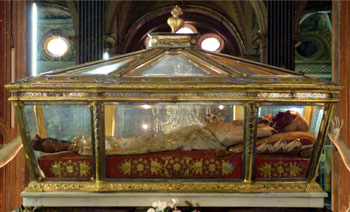 St. Catherine's incorrupt body in a Genoese church named after her |
Comments of Prof. Plinio:
In this selection we have two parts: the first describes the life of the Saint; the second presents her considerations on Purgatory.
In the biographical part, we see that Catherine was a soul chosen by God who, nonetheless, did not corresponded to His call. She married instead of becoming a religious; she entered into a worldly life that caused her much suffering, but also we see that she enjoyed being admired in worldly society. For some years she was concerned only about these pleasures without thinking about the cause of God. Then a marvelous conversion took place.
At that time many people used to enter the religious life. Even in the noblest families some of the children always entered religious life, the clergy or an order of chivalry. It was very common to become a religious. Catherine, therefore, had a sister in a convent in Genoa whom she went to visit.
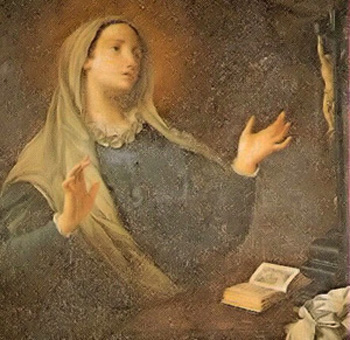 The realization of God's love in contrast with her own sins worked her immediate conversion |
She made the decision to return and entered into ecstasy where she clearly saw the horror of the sins she had committed. After that, she entered a life of great penance and prayer that she maintained for the rest of her days. During all this time, she never lost sight of that vision she had of her sins. Her life thus became one of a penitent.
She took up the care for the sick in the Pammatone hospital – she who had been a lady of great honor, noted for her beauty, charm of conversation, social situation and wealth in one of the most illustrious cities of that time, which was Genoa. Genoa was an aristocratic republic that dominated a part of the Mediterranean Sea. She left all that behind and became a humble nurse of the sick, going from one patient to another to make penance and mortify herself.
The idea of expiating sin by means of suffering is an idea that dominated her new life. She delivered herself to a true purgatory in this life. She wanted to help others and offer her sufferings in expiation for the sins she had committed.
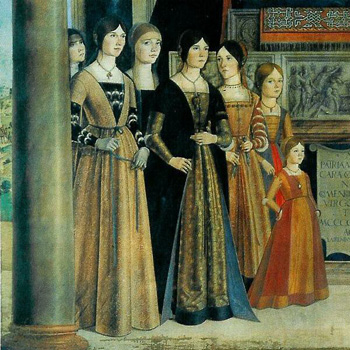 Dresses of Italian ladies of good society in the late 15th century |
There are souls who fight against God; nonetheless God pursues them obstinately. They flee from Him, at times they even turn against Him; but, at a determined moment, He conquers them and they deliver themselves fully to Him. One of these souls was St. Paul. Catherine of Genoa is another example.
Catherine tried to escape the path of God. He did not turn her away, but put suffering in her life. She bore the suffering, which prepared her for conversion. The bad husband and her frustration with the world prepared her soul for that blessed moment when her sister gave her a good counsel. Her soul had been prepared by many sufferings. At that moment she was like the prodigal son. She returned to the paternal home. She returned and was conquered by God in a magnificent way.
Pope explains the visions of Saint Catherine of Genoa on purgatory
Purgatory, a place of peace & suffering
Instead of just inspiring her with pious thoughts, He sent her a vision in which she could clearly evaluate the sins she had committed. She could say, perhaps more truly than David, those words: “Against Thee only, I have sinned, my God, and my sin is ever before me.” Her sin was standing before her like an accuser clearly stating her transgressions.
I understand that someone could think that God was extremely severe to show her sins in this way, thus producing such distress, sadness and discouragement in her spirit. In fact, a person who thinks this does have a clear notion of what contrition is. He does not comprehend that, even amid its sadness, in contrition there is something encouraging and magnificent. I would say that these are the beautiful and magnificent joys of contrition. Contrition translates the sentiments one has in Purgatory.
Related:
http://tradcatknight.blogspot.com/2015/11/the-pope-who-begged-for-help-from.html
http://tradcatknight.blogspot.com/2016/03/the-church-suffering.html
Purgatory is par excellence the place of contrition. In it are
the souls who must purify themselves before they can see the essence of
God. St. Catherine of Genoa described what Purgatory is in a very
elevated and also very concise way.
She explained how when a good soul dies, it has a first notion of the infinite purity of the essence of God and of the contrast between this purity and the remains of sin in the soul. Simultaneously the soul has a notion of the possession of God, Whom it will enjoy for all eternity, and a clear notion of the unpreparedness of his own soul to be in God's presence.
So, the soul experiences a twofold movement: One filled of joy that leads it to unite with God; another of deep sadness that comes from the contrast between its own stains and the infinite purity of God. From the desire to unite with God, the desire for purification comes.
St. Catherine said that the soul is so taken by the love of God that it would voluntarily suffer a thousand Hells in order to unite itself to Him. It is eager to enter Purgatory to purify itself and thus prepare to finally be united with God. Thus. It experiences a fundamental joy along with the great sadness that comes from not being with Him.
We see that some of this exists in the peace of a soul who has true contrition. Perhaps you recall those words in the Penitential Psalms of David that are like sparks of fire falling from Heaven. He says that his sin had made him like a solitary bird on a roof. It is a very poetic figure to describe the solitude of the sinner and his own sorrow. He is a bird on the rooftop exposed to the rain and cold, far from the society of those virtuous men who love one another.
At the same time that he describes his own great sorrow, he transmits the peace that exists in the soul of a repentant sinner. It is the peace of the man who recognizes his sin, who does not lie to himself or to God but has the courage to look his own sin in the face. In general those Penitential Psalms end with a canticle of hope: “But Thou, my God, art my salvation, and Thou shall have pity on me.” This is also what should have happened with St. Catherine of Genoa.
We can imagine the large Pammatone Hospital in Genoa of that time: a beautiful edifice, as the Italian hospitals used to be. It is 5 a.m., still at dawn and a small bell rings to announce that the Mass will start. The first faithful women covered with their veils enter the chapel; among them is St. Catherine. Perhaps she still is remembering other dawns when she was arriving home from parties at about that time. Before her, she has the perspective of a full day of sacrifices, at the same time she has the bitter lingering memories of nights of pleasure followed by the inevitable frustration.
She enters the chapel with light steps, kneels and starts to pray in the
recollection of that sacred place, attending a Mass that was a true
Mass with faithful who were truly faithful and a priest who was truly a
priest. The early morning light is entering the chapel, overtaking the
light of the flickering candle flames; nature is waking up, she feels
the normality of the life of yet another day. She prepares herself to
begin another day of her great penance in caring for the sick; she is
preparing herself to hear their groans, attend to their agonies and
console their grief. As the light of day enters the chapel and the dawn
becomes day, the images in the chapel regain their colors.
But, beyond all this, another light is increasing and drawing ever nearer. It is a forgiveness that comes; it is a peace of soul that arrives in the very heart of that chapel. It is in this peace that she dies and, then, it is no longer the chapel that she sees, but Heaven. She dies in the tranquility of contrition that has the sweet perfume of a Catholic sadness and resignation, something that the pagan soul does not know and that is worth incomparably more that all the pagan pleasures.
When one speaks of mortification and sadness in spiritual life, some persons become ruffled. They do not understand this joy and happiness that I am trying to describe, for there is something in it that human words can never adequately portray. It is a mixture of bitterness and hope, of sadness and peace, where the hope has more weight than the bitterness and the peace much more worth than the sadness.
This is what the world does not know and what being a member of the true Church allows us to understand. It is a Purgatory on earth; it is the valley of tears in which we live. If we bear our cross with resignation we will have torrents of peace, stability and order in our souls. No one following the worldly path can have an idea of this joy and peace.
What we find in the life of St. Catherine of Genoa is the great example of one carrying her cross amid peace and resignation. Let us ask her to intercede for us and make us see in the interior of our souls these graces that are not easy to describe. Let us ask Our Lady to give us the peace and joy of a true contrition.
Instead of just inspiring her with pious thoughts, He sent her a vision in which she could clearly evaluate the sins she had committed. She could say, perhaps more truly than David, those words: “Against Thee only, I have sinned, my God, and my sin is ever before me.” Her sin was standing before her like an accuser clearly stating her transgressions.
I understand that someone could think that God was extremely severe to show her sins in this way, thus producing such distress, sadness and discouragement in her spirit. In fact, a person who thinks this does have a clear notion of what contrition is. He does not comprehend that, even amid its sadness, in contrition there is something encouraging and magnificent. I would say that these are the beautiful and magnificent joys of contrition. Contrition translates the sentiments one has in Purgatory.
Related:
http://tradcatknight.blogspot.com/2015/11/the-pope-who-begged-for-help-from.html
http://tradcatknight.blogspot.com/2016/03/the-church-suffering.html
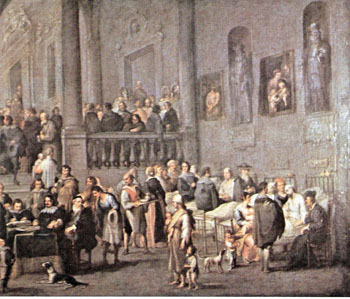 The large Pammatone Hospital in Genoa where Catherine made her purgation on this earth |
She explained how when a good soul dies, it has a first notion of the infinite purity of the essence of God and of the contrast between this purity and the remains of sin in the soul. Simultaneously the soul has a notion of the possession of God, Whom it will enjoy for all eternity, and a clear notion of the unpreparedness of his own soul to be in God's presence.
So, the soul experiences a twofold movement: One filled of joy that leads it to unite with God; another of deep sadness that comes from the contrast between its own stains and the infinite purity of God. From the desire to unite with God, the desire for purification comes.
St. Catherine said that the soul is so taken by the love of God that it would voluntarily suffer a thousand Hells in order to unite itself to Him. It is eager to enter Purgatory to purify itself and thus prepare to finally be united with God. Thus. It experiences a fundamental joy along with the great sadness that comes from not being with Him.
We see that some of this exists in the peace of a soul who has true contrition. Perhaps you recall those words in the Penitential Psalms of David that are like sparks of fire falling from Heaven. He says that his sin had made him like a solitary bird on a roof. It is a very poetic figure to describe the solitude of the sinner and his own sorrow. He is a bird on the rooftop exposed to the rain and cold, far from the society of those virtuous men who love one another.
At the same time that he describes his own great sorrow, he transmits the peace that exists in the soul of a repentant sinner. It is the peace of the man who recognizes his sin, who does not lie to himself or to God but has the courage to look his own sin in the face. In general those Penitential Psalms end with a canticle of hope: “But Thou, my God, art my salvation, and Thou shall have pity on me.” This is also what should have happened with St. Catherine of Genoa.
We can imagine the large Pammatone Hospital in Genoa of that time: a beautiful edifice, as the Italian hospitals used to be. It is 5 a.m., still at dawn and a small bell rings to announce that the Mass will start. The first faithful women covered with their veils enter the chapel; among them is St. Catherine. Perhaps she still is remembering other dawns when she was arriving home from parties at about that time. Before her, she has the perspective of a full day of sacrifices, at the same time she has the bitter lingering memories of nights of pleasure followed by the inevitable frustration.
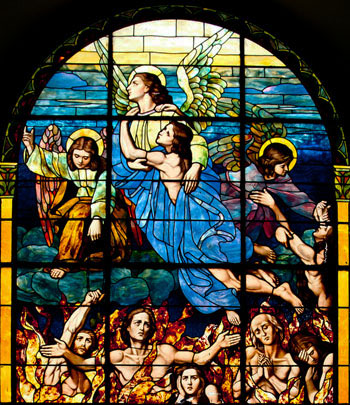 The souls in Purgatory suffer with a serene joy as they await eternal union with God |
But, beyond all this, another light is increasing and drawing ever nearer. It is a forgiveness that comes; it is a peace of soul that arrives in the very heart of that chapel. It is in this peace that she dies and, then, it is no longer the chapel that she sees, but Heaven. She dies in the tranquility of contrition that has the sweet perfume of a Catholic sadness and resignation, something that the pagan soul does not know and that is worth incomparably more that all the pagan pleasures.
When one speaks of mortification and sadness in spiritual life, some persons become ruffled. They do not understand this joy and happiness that I am trying to describe, for there is something in it that human words can never adequately portray. It is a mixture of bitterness and hope, of sadness and peace, where the hope has more weight than the bitterness and the peace much more worth than the sadness.
This is what the world does not know and what being a member of the true Church allows us to understand. It is a Purgatory on earth; it is the valley of tears in which we live. If we bear our cross with resignation we will have torrents of peace, stability and order in our souls. No one following the worldly path can have an idea of this joy and peace.
What we find in the life of St. Catherine of Genoa is the great example of one carrying her cross amid peace and resignation. Let us ask her to intercede for us and make us see in the interior of our souls these graces that are not easy to describe. Let us ask Our Lady to give us the peace and joy of a true contrition.
